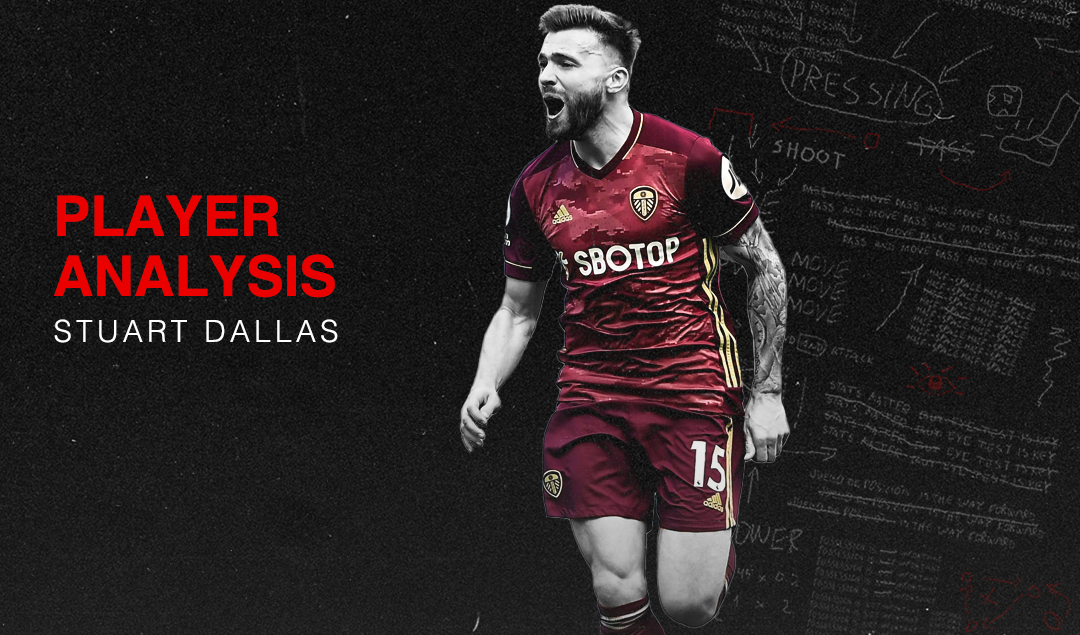Stuart Dallas: The Versatile Footballer
Despite being promoted to the Premier League after 16 years, Leeds United have had a wonderful season. Marcelo Bielsa’s side has played effective football at the same time, they have equally gifted spectators with amazing football. Leeds’s free-flowing football, the constant rotation of the players, the gradual attack with holding the ball possession delighted the spectators.
Anyone who hasn’t followed the Premier League may suddenly see the points table and won’t realize how fantastic football Leeds actually played. Behind this beautiful football, there is the contribution of several players of the team. One key player of them is Stuart Dallas. He had been a symbol of coach Bielsa’s confidence throughout the season.
He has played in different positions for the needs of the team throughout the season, but he was impeccable in all the positions. He was one of the most versatile players in the entire Premier League last season. He scored eight goals for Leeds last season, four of which came from outside the box.
Leeds did not have enough backup in every position and players suffered frequent injuries due to high workloads and there was a lack of adequate players on the bench. That’s why Dallas had to play in several positions throughout the season. But his performance in every position was great and Bielsa’s confidence in him has paid off with his consistent performance throughout the season.
Left-back
Beginning of the last season, Dallas was seen playing as a left-back. Though he played as a left-back, his role was far different from the usual left-backs. Being a right-footed player, he played as an inverted left-back instead of the usual left-backs. As Jack Harrison acted as a touchline winger, Dallas had the freedom to occupy the half-space and got more chances to involve more in the build-up.


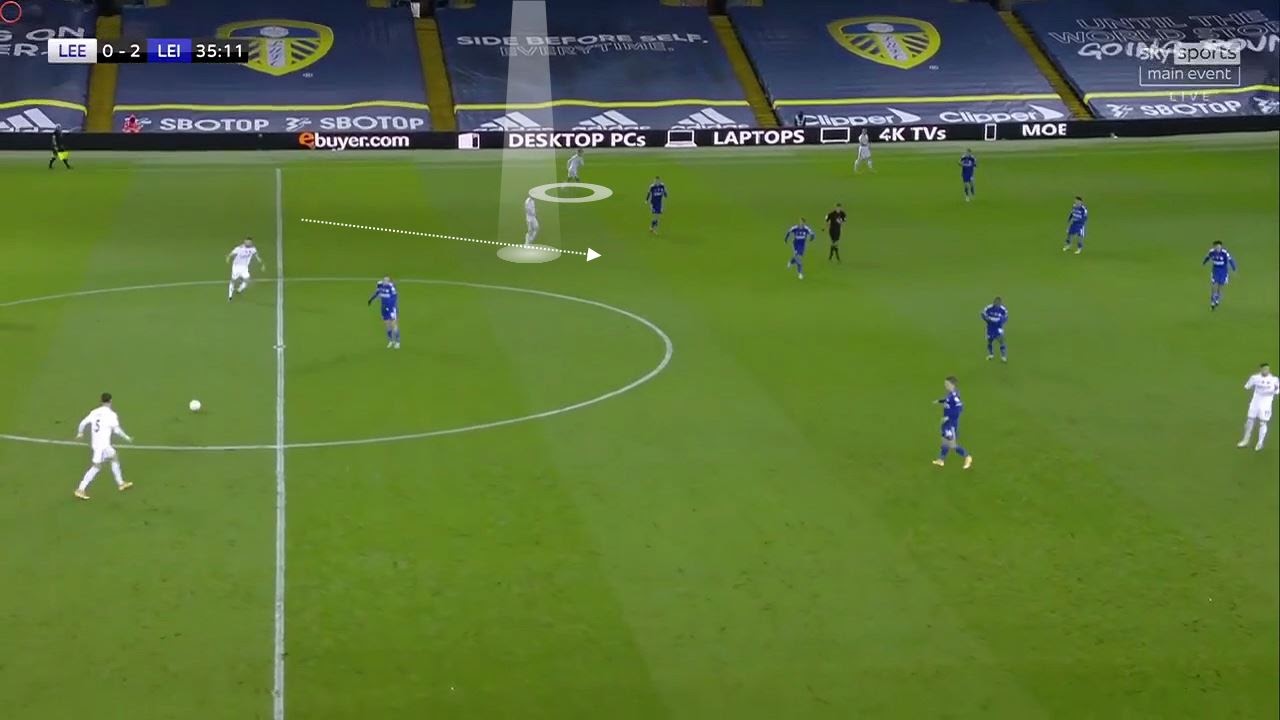
In this image above, Dallas took his position in the central area like an inverted left-back instead of staying near the touchline. Leeds United generally builds the play from the back and constantly invites the opponents to press them.
Dallas doesn’t position himself near the touchline because he needs time to pass with his weak left foot under pressure, but usually, he doesn’t get enough. Hence he stays more centrally in the build-up phase. Consequently, he can beat opponents’ pressing easily by giving passes in the left flank to enlarge the passing zone using his strong right foot.

Due to the high intensive press of the Manchester City forwards, Dallas took his position in the half-space and received the ball, and quickly attempted a pass towards Hélder Costa using his right foot. Dallas usually makes overlapping runs in the counterattack. In this case, he makes an inside run towards the half-spaces, and the winger (usually Harrison) is progressing the ball forward near the touchline.

Harrison received the ball from Mateusz Klich near the touchline, then Dallas grabbed the halfspace and made a forward run through the free space of Leicester’s defense line. But usually, he holds his position in the half-spaces outside the opponents’ box instead of going forward. So, if Leeds loses the ball, he acts as a shield in front of the opponents’ counterattack, recycling the ball after regaining the ball possession.

When Harrison moved forward towards the left flank with the ball, instead of overlapping Dallas stayed in the halfspace outside Liverpool’s box operating as a playmaker. Being strong in the right foot, Dallas shows reluctance to cross while playing as a left-back. As he positions himself in the half-spaces in front of the opponents’ defense line, he gets some pocket of space to turn and make inswing crosses.
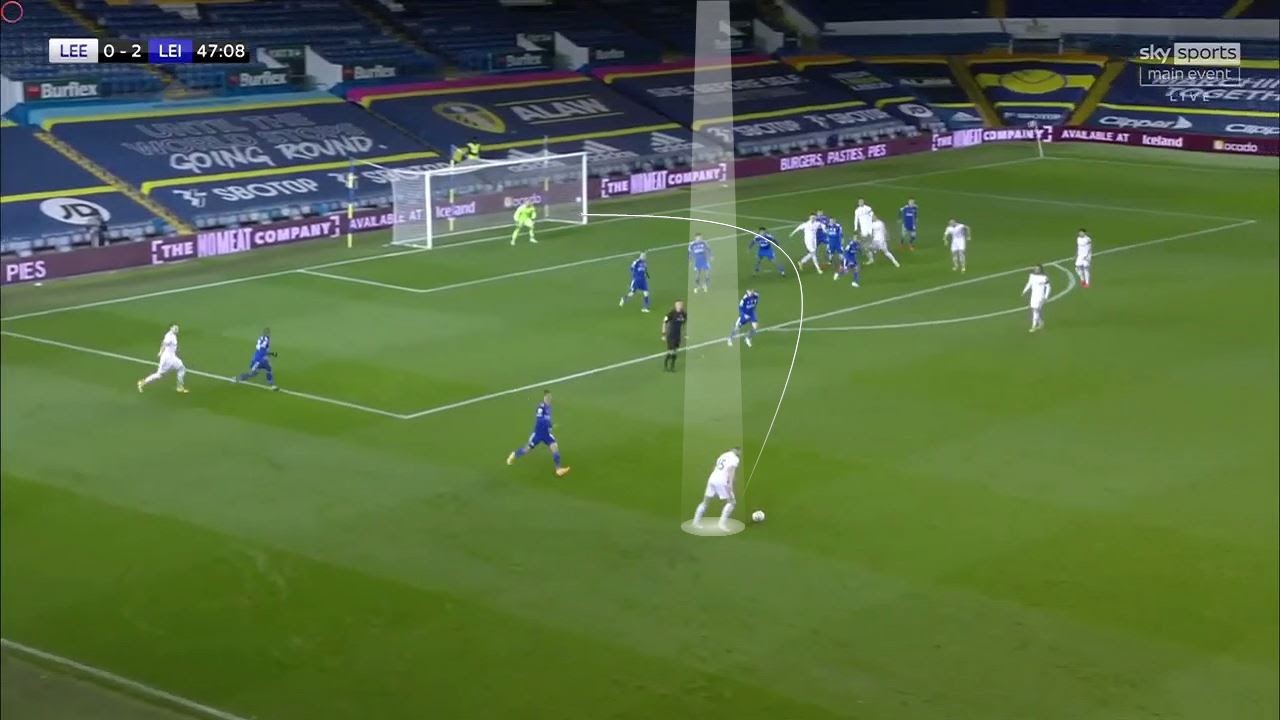
Inswinging cross from left half-space by Dallas, although the final goal was scored directly from this cross.

Inswinging cross of Dallas using the right foot from the left half-space again.
If opponents hinder the passing channel in the center area, Leeds usually tries to progress the ball using the wide areas. As in the wide area, only one directional pass can be made, it is hard to progress the ball against opponents’ pressing. Hence, Leeds tries to progress the ball by generating triangles near the touchline and making quick one-two-one passes.
During progressing the ball in the left-wing, left-back Dallas and left winger (usually Harrison) have occupied themselves near the touchline, and the left midfielder has occupied the half-spaces. At this time, Dallas makes a quick 1-2 pass to Harrison or left midfielder and makes a diagonal run towards the half-spaces. Harrison drags opponents’ right-back out of the position and thus Dallas gets enough free spaces to move quickly with the ball through the half-space channel.
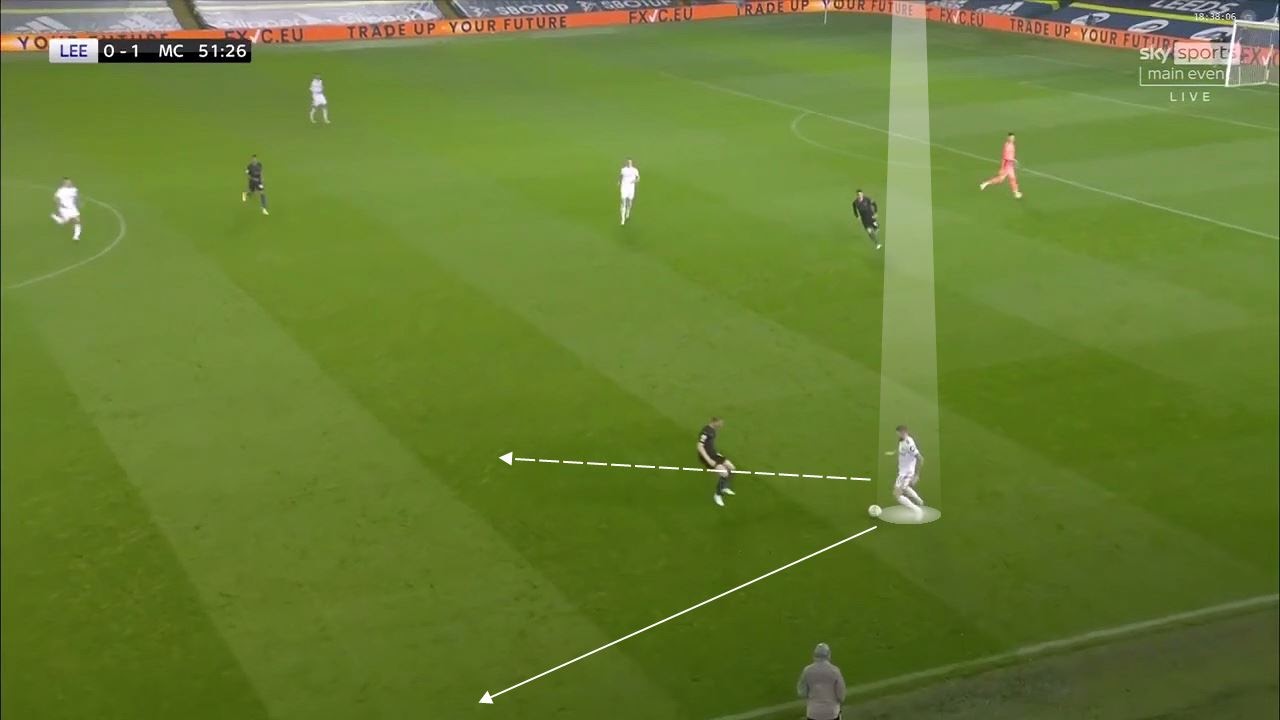
Let’s take a look at the picture above. Dallas quickly received the ball, passed to Costa on the left side with his right foot, and made a diagonal run through the half-space.
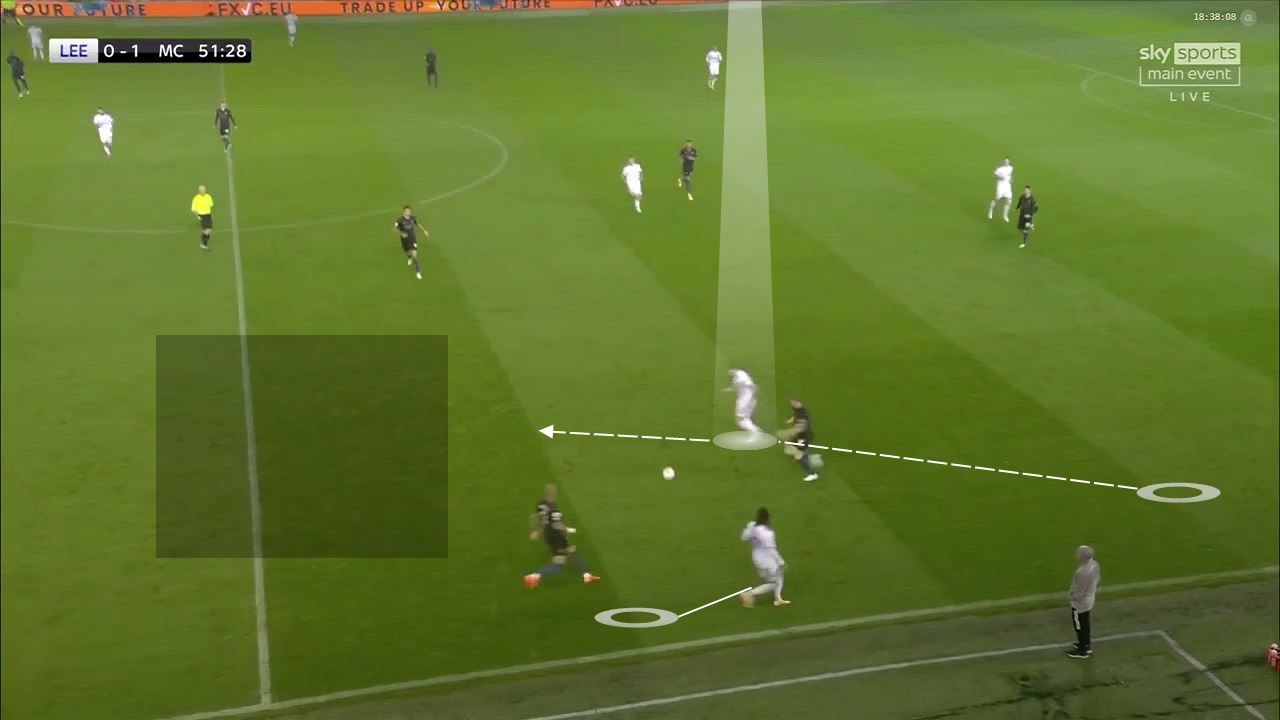
City’s right-back Kyle Walker marked Costa and came high up on the pitch creating huge free space behind for Dallas to move the ball forward.

There are some exceptions here. Dallas made a quick forward run after passing Harrison in the halfspace, Costa stretched the line.
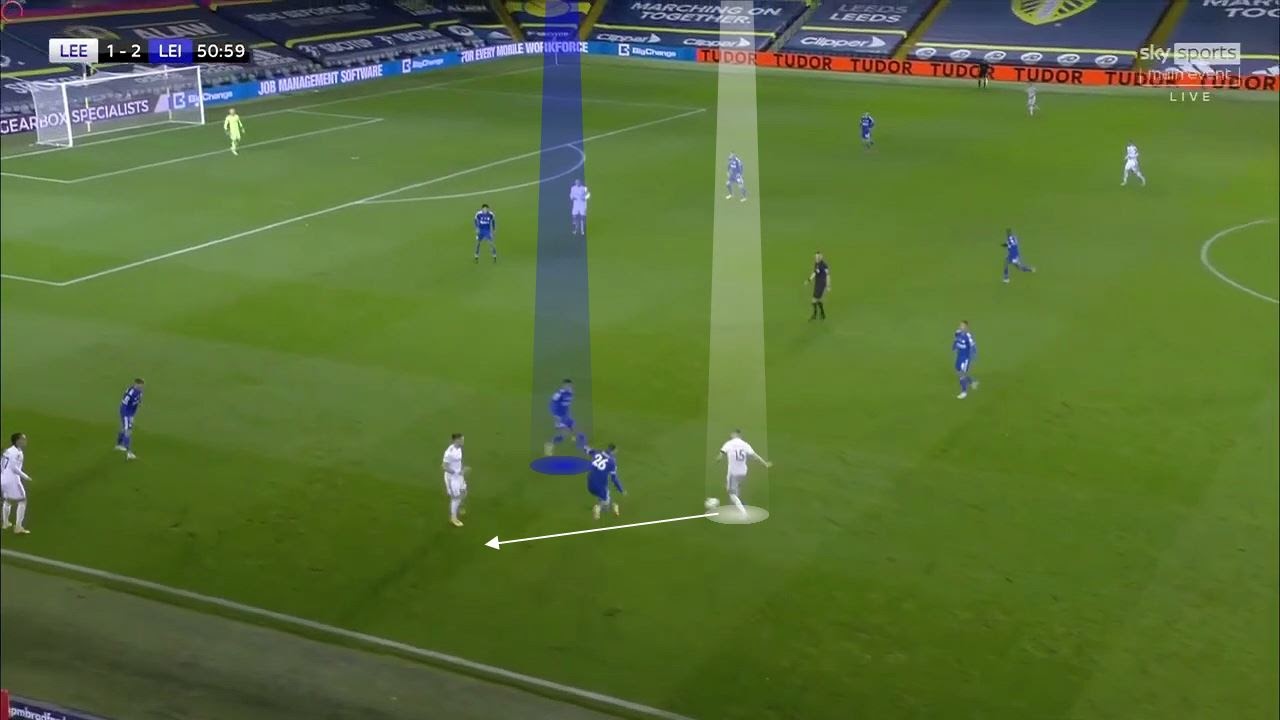
But the half-space was occupied by Leicester’s right-back James Justin which forced Dallas to return the ball to Harrison using his left foot.
Right-back
In the early part of the season, due to the injuries of Liam Cooper, Robin Koch, and Diego Llorente, Luke Ayling had to play as a center-back in several matches. That time Dallas was seen playing in the right-back position. With Dallas being naturally right-footed, he didn’t have much trouble playing in the right-back position.
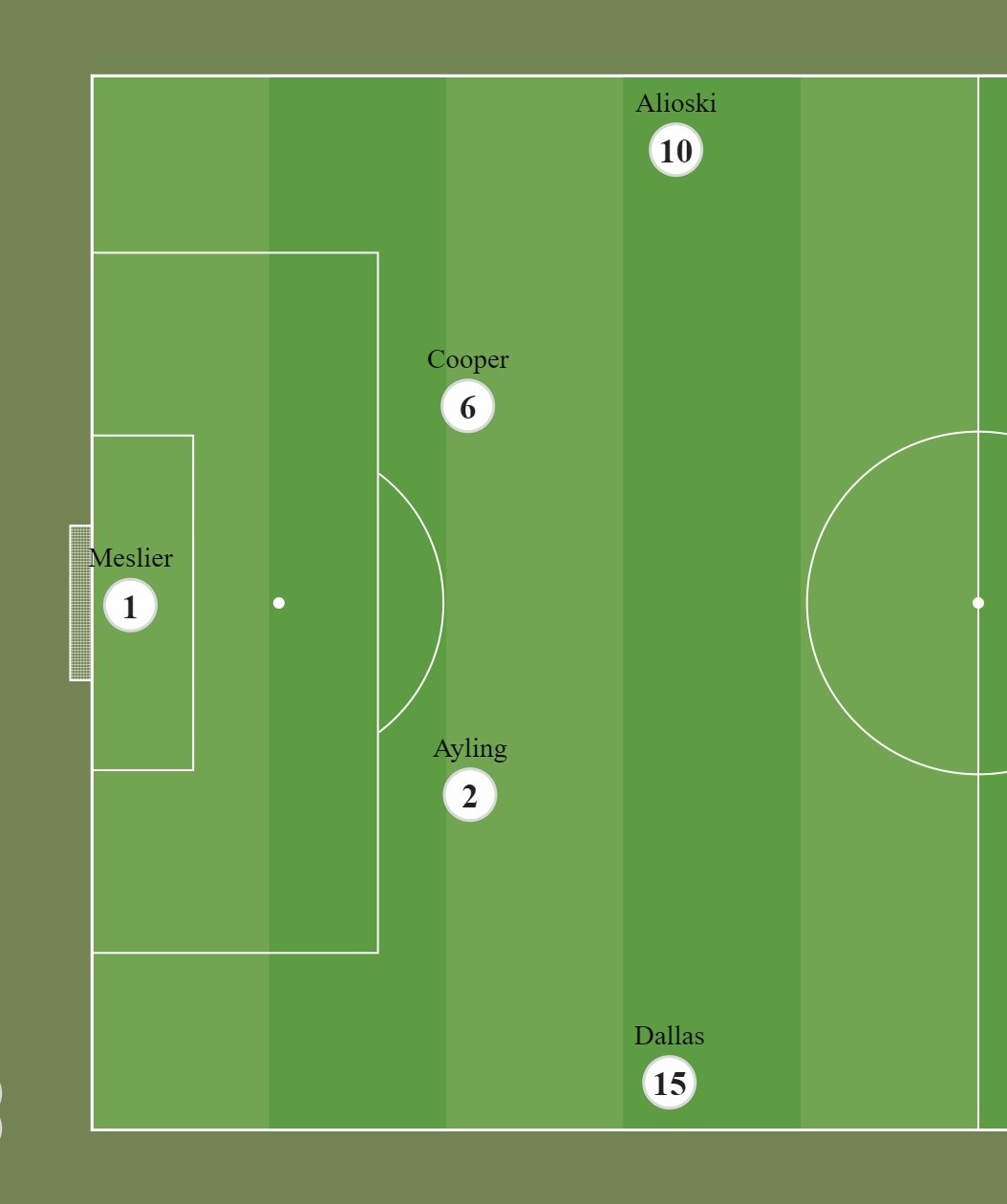

Dallas has made back four holding the right-back position. Leeds usually plays 4-1-4-1 formation, but usually, their formation depends upon the opponents’ formation. Bielsa generally uses one more center-back than the number of strikers in the opposing team to gain numerical superiority in defense.
Therefore, when the opponent plays with two forwards, Luke Ayling drops down and plays as a right center-back. At this time, being a box-to-box midfielder, Dallas switches his position and plays in the right wing-back position.

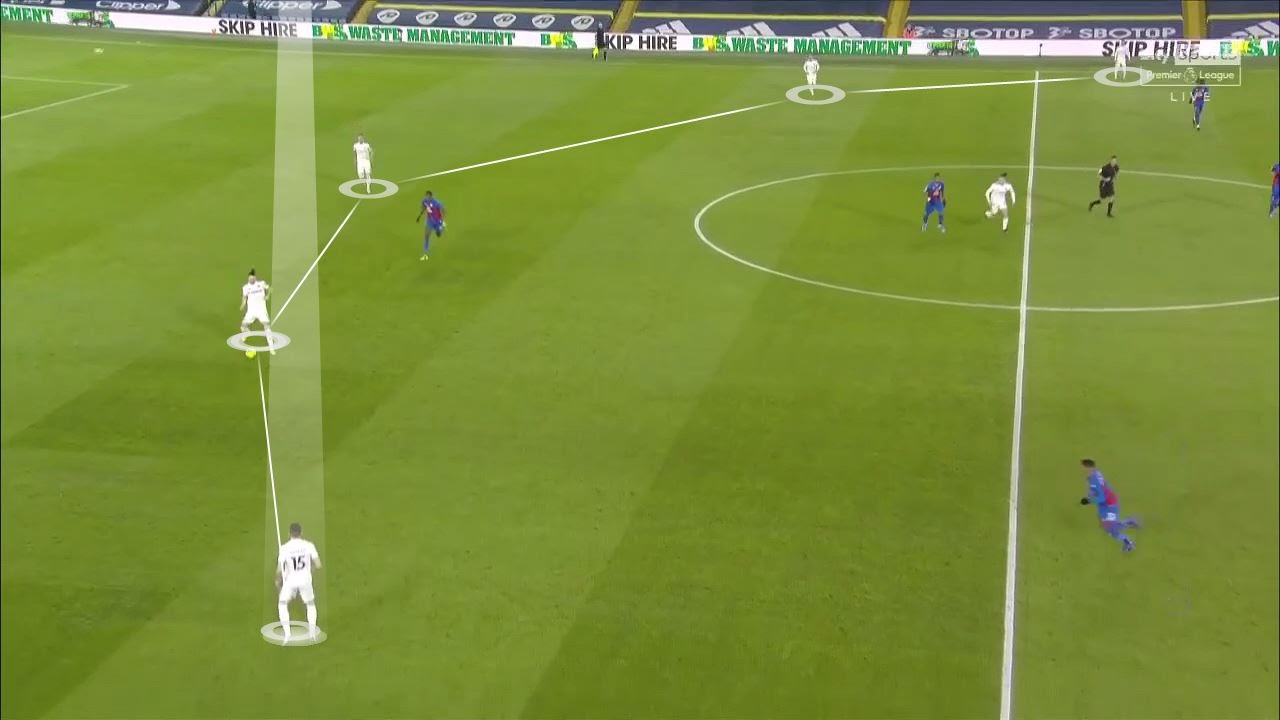
In the match against Crystal Palace, Crystal Palace played with two forwards Jordan Ayew and Jean-Philippe Mateta which made Ayling play from right back to center back position. Dallas then played as a right-wing-back at the beginning of the match.
Dallas’s role was much like an inverted left-back while playing as a left-back. But when playing as a right-back, Dallas has taken overlapping runs near the touchline like normal right-backs, and most of the time he has attempted crosses from the touchline area in the offensive transition. Because Dallas stretched the line while being positioned near the touchline, Raphinha got the freedom to cut inside centrally.
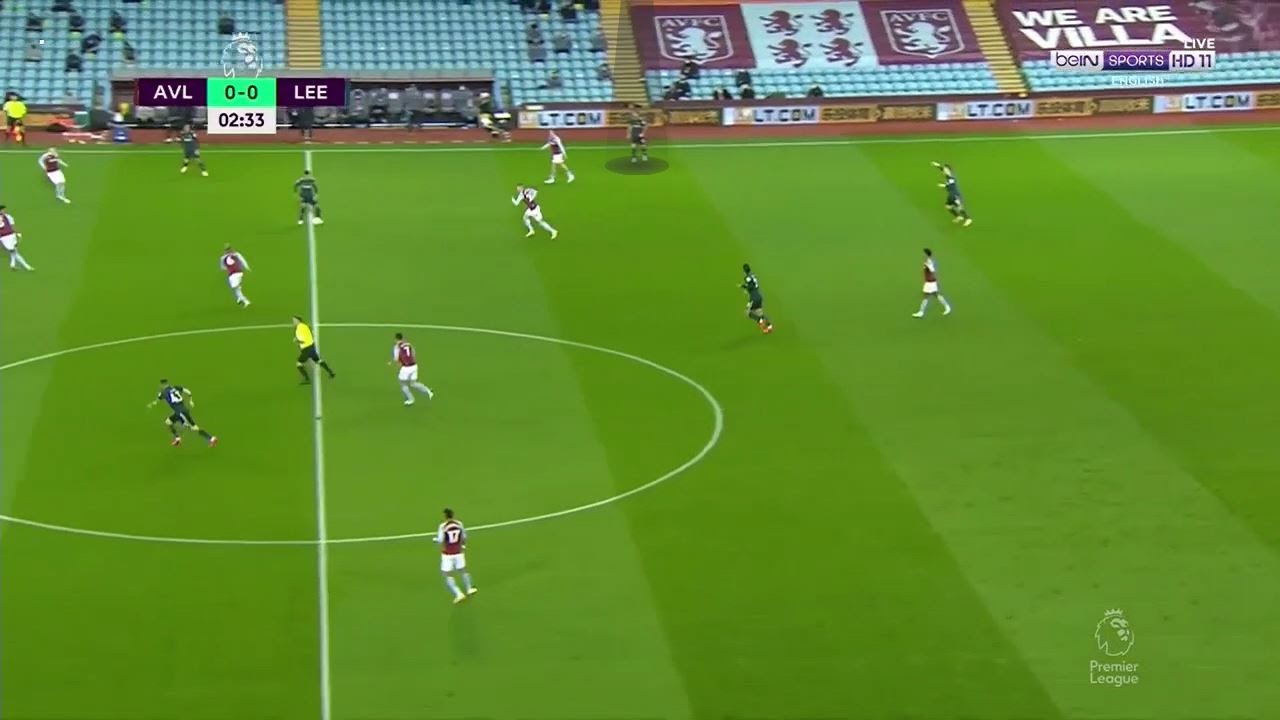
In the buildup phase, Dallas holds his position near the touchline area.
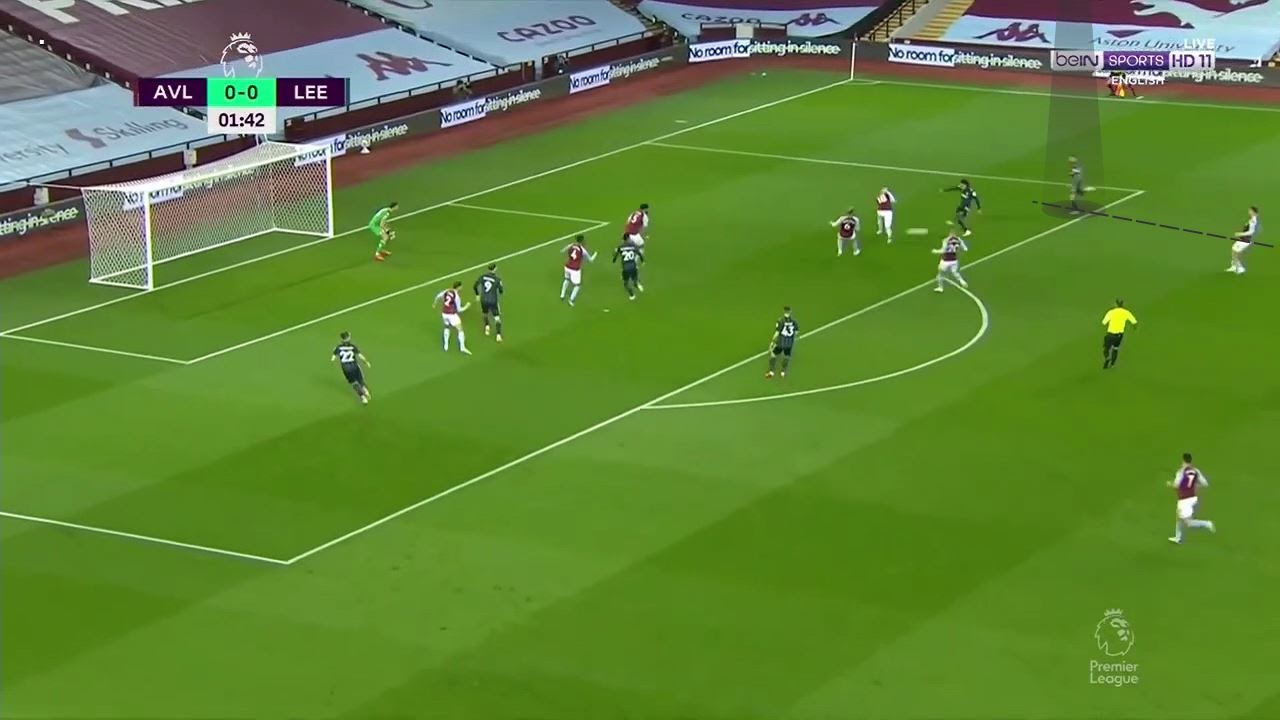
Dallas took an overlapping run while Costa cut inside trying to attempt from inside the box.
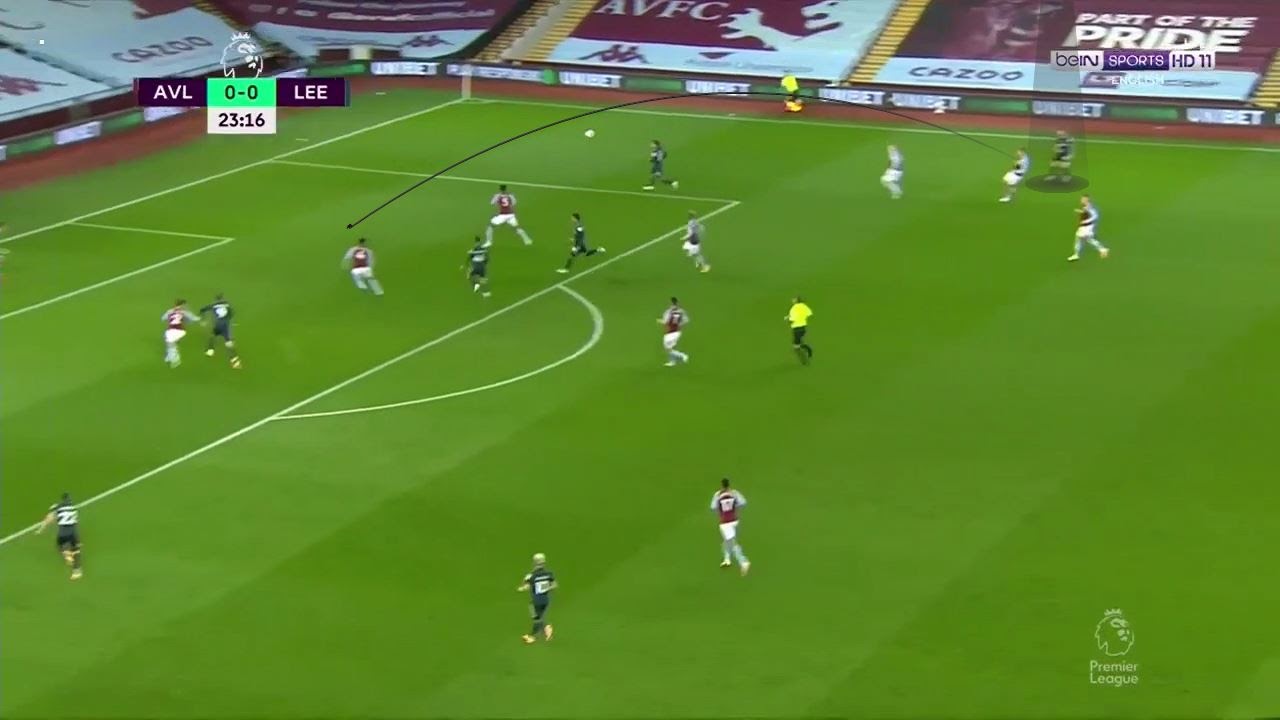
Dallas’s cross inside the box from the right-wing.
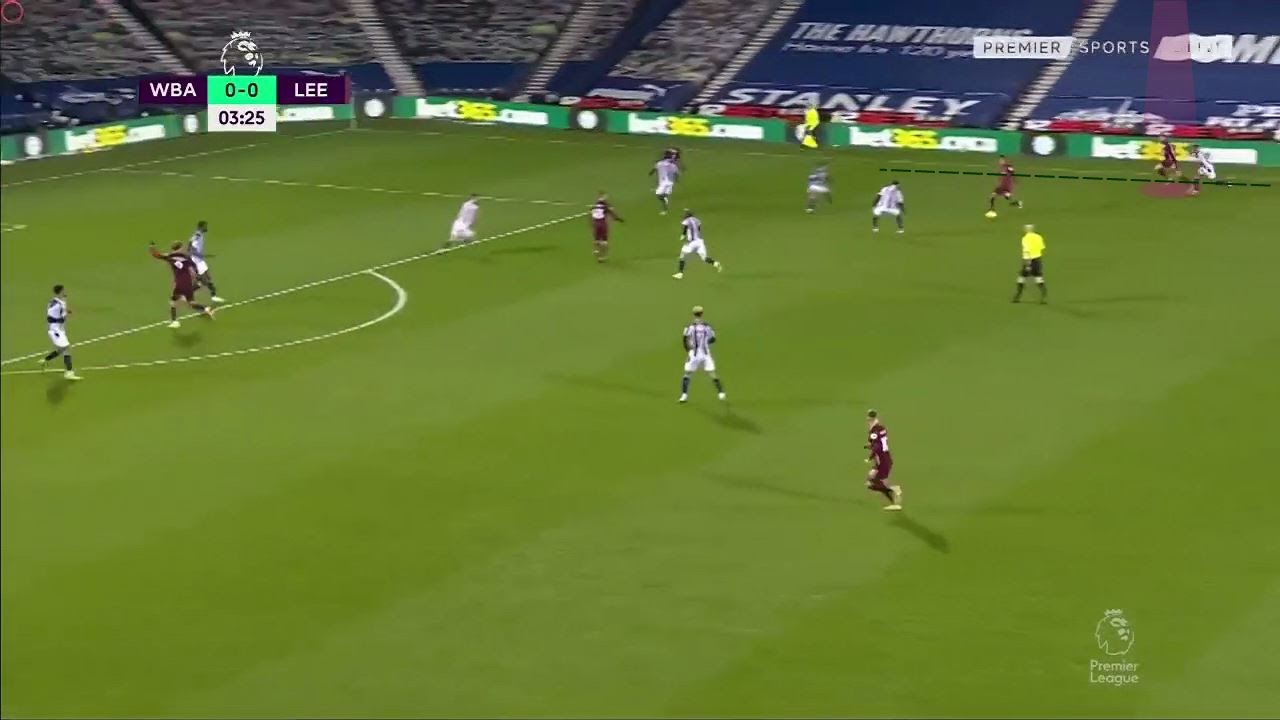
In the example above, while Raphinha cut inside from the right-wing, Dallas tried to stretch the defense line making an overlapping run through the touchline.
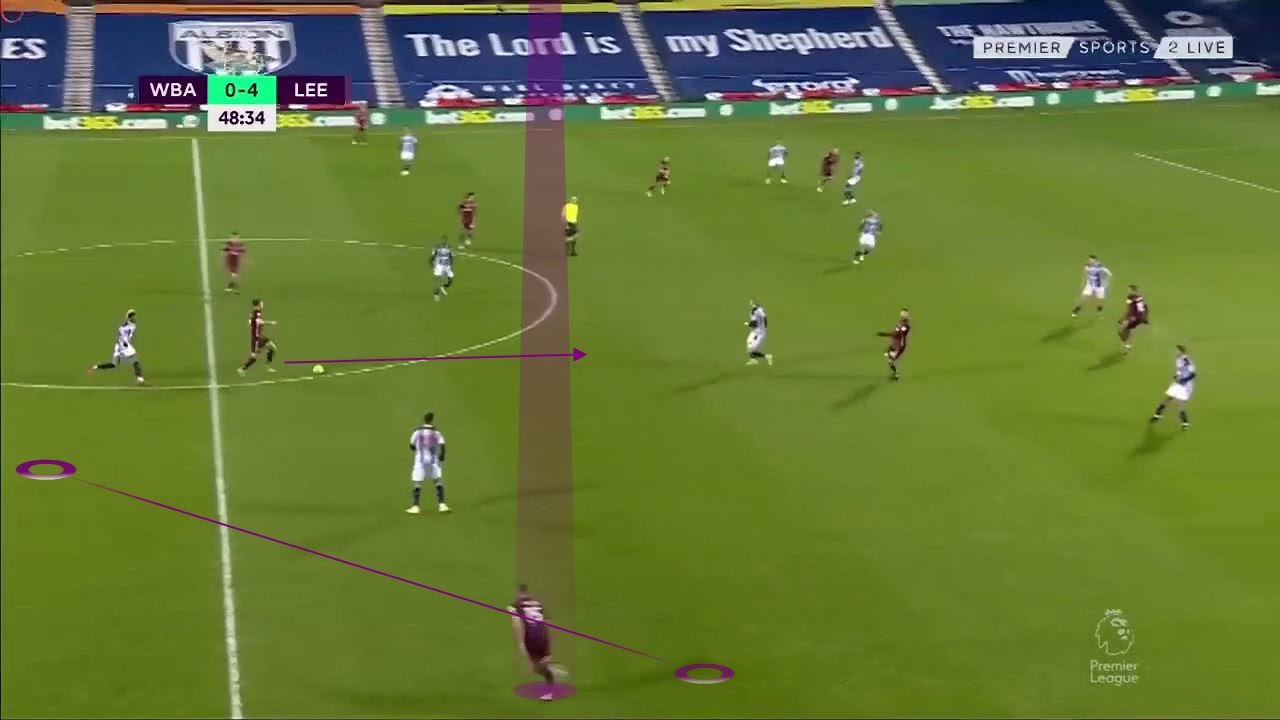
Ayling often has played as a right center-back when Dallas has played as a right-back. During the buildup, Ayling has played the role of the main ball progressor and he loves to move forward with the ball. While Ayling moves forward with the ball, it exposes huge free space in the defense line. At this time, Dallas moves centrally rather than overlapping and tries to cover the space left by Ayling.
Alike the left side, Leeds usually generates a triangle on the right wing and progresses the ball forward. However, when Dallas has played in the right-back position, Leeds creates a slightly different pattern of the passing triangle. During his forward movement, Dallas moves forward with a vertical run through the touchline or half-space instead of a diagonal run and tries to shield the ball from the opponents’ pressing with his right foot.

Dallas made a quick one-two-one with Jamie Shackleton and moved forward through the half-space.

West Brom’s left-back Lee Peltier tracked Shackleton and pushed high up on the pitch which exposed free spaces behind West Brom’s defense. Then from Dallas’s pass towards Raphinha, Raphinha took a long-range shot which led to a goal.
While playing in the right-back position, Dallas is usually seen holding his position near the touchline area, but whatever he always loves to come to the central area and be more involved in the buildup. The following picture is an example of this.

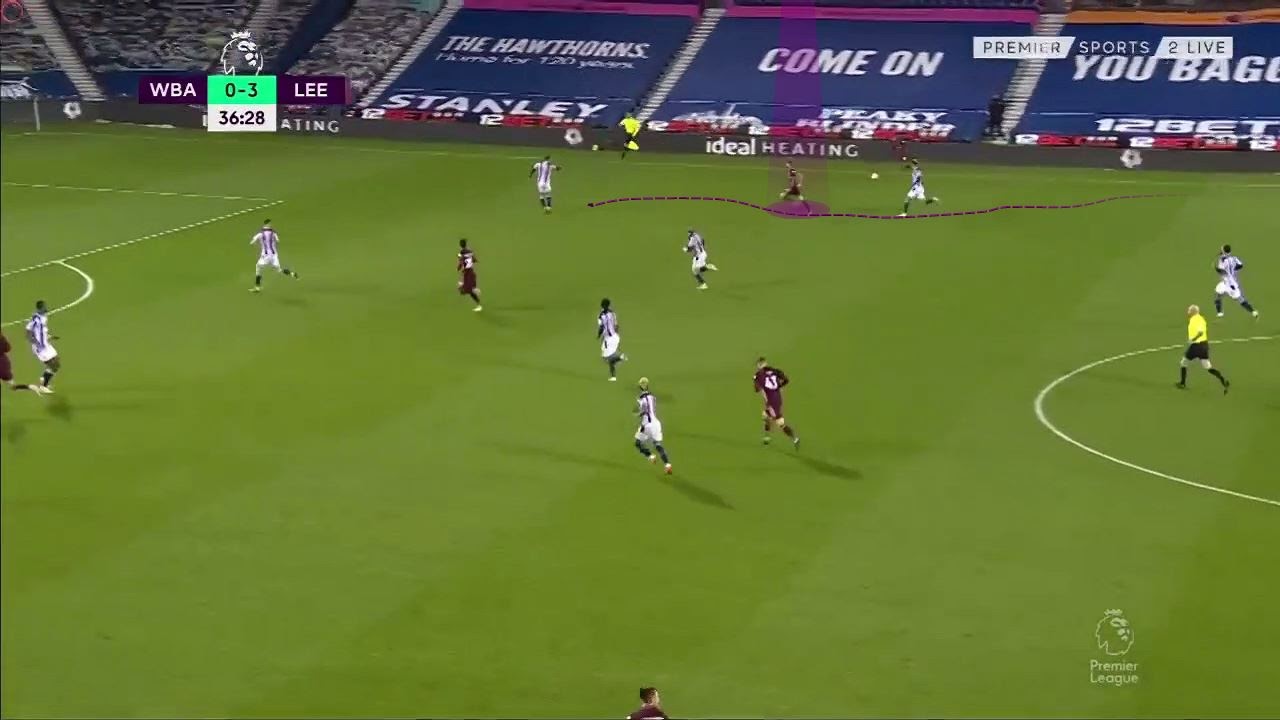
Here, when Raphinha moved forward through the right-wing, Dallas made a run towards the space between West Brom’s center back and left-back and made quick one-two with Raphinha and cut inside the box.
Box-to-Box Midfielder
Dallas has been seen playing as a box-to-box midfielder in most of the matches last season. Four of Dallas’s 8 goals last season were out of the box. Though he played as a defender early on, Bielsa played him as a midfielder the rest of the season to give him more attacking freedom and to get the best output for Dallas’s shooting and scoring abilities.

Dallas’s positioning as a midfielder. Dallas’s role as a midfielder is to participate in the buildup play by dropping deep during the buildup and receiving passes by beating the marker through continuous rotation.
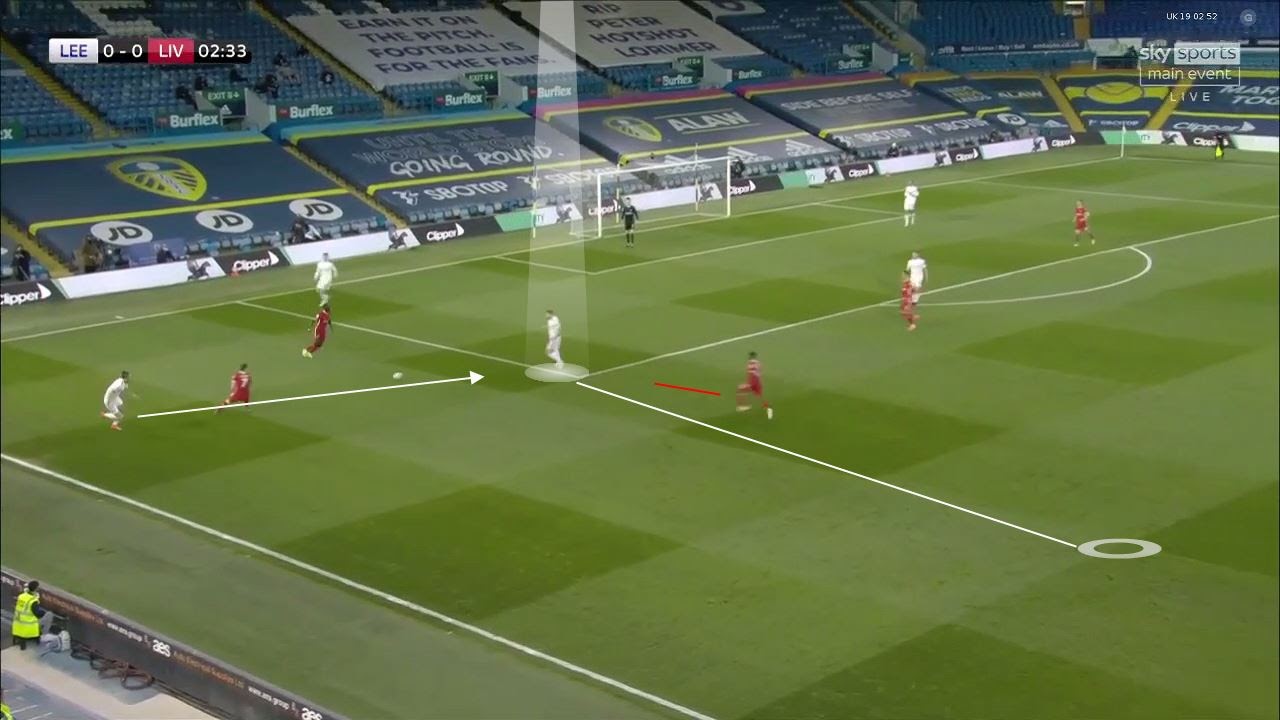
In the example above, Liverpool’s forward players continued to press Leeds’s defenders during the buildup from the back. At that time, Dallas dropped from midfield to the defense and received the ball from Ayling to get numerical superiority. After tracking Dallas, Georginio ‘Gini’ Wijnaldum came high up on the pitch which created a lot of free space in the midfield.

Liverpool players blocked all possible passing options when Ayling moved forward receiving the ball. At that point, Dallas tried to create a passing channel by moving from his position towards Ayling.

Dallas quickly switched the ball to Harrison on the left wing after regaining the ball from Ben Chilwell in the center half.

Although Ayling has played as a right-back, he is confident with the ball and often tries to progress the ball forward through the center area. In this image, Dallas moved from the central area to the right side and tried to cover the space left by Ayling. Ayling passed to Dallas as two Liverpool players came to press him. In the offensive phase, Leeds’s front five players combine to form the five-man frontline.
During this time, Patrick Bamford takes his position in the center area, with two wingers trying to stretch the opponent’s defensive line by taking their position on the touchline, and two number #8 trying to use the free space between the center-back and fullback in the halfspace. While Dallas plays in the No. 8 role, he usually takes a slightly lower position than the other 4 forward players, so that he can easily circulate the ball in the pocket space in front of the opponents’ frontline.

In the picture above, Dallas is much behind than the other four forward players.

Here Dallas took position slightly behind the rest of the forwards which created quite a bit of free space. Therefore, by receiving the pass from Harrison, he got the opportunity to give a line-breaking pass without any pressure from the opponent.
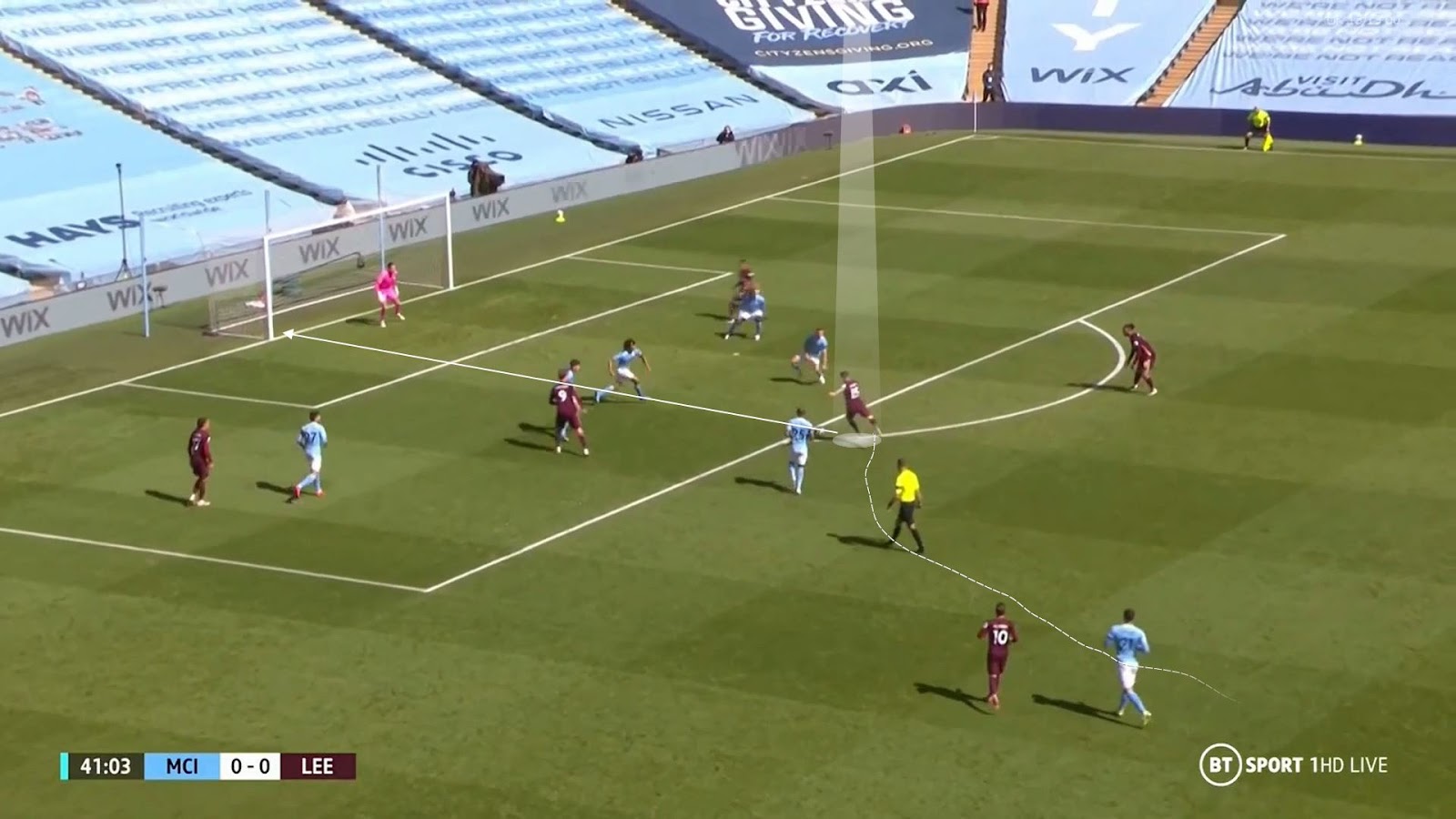
Here Dallas made a bit of a late move so he got a pocket of space in front of City defenders from Bamford’s backpass so he could easily take shot attempts and scored a goal.
Dallas’s one more positive aspect is his forward movement. Bamford usually drags opposing defenders out of position, creating free space behind the opponent’s defensive line. Dallas has tried to exploit that free space with a forward run.


In the example above, when Bamford moved towards half-space, Leicester’s center back Wesley Fofana tracked him and moved towards half-space. With that, the center area became free. Dallas took a forward run in that free space, exploiting Leicester’s defense and scoring a goal.
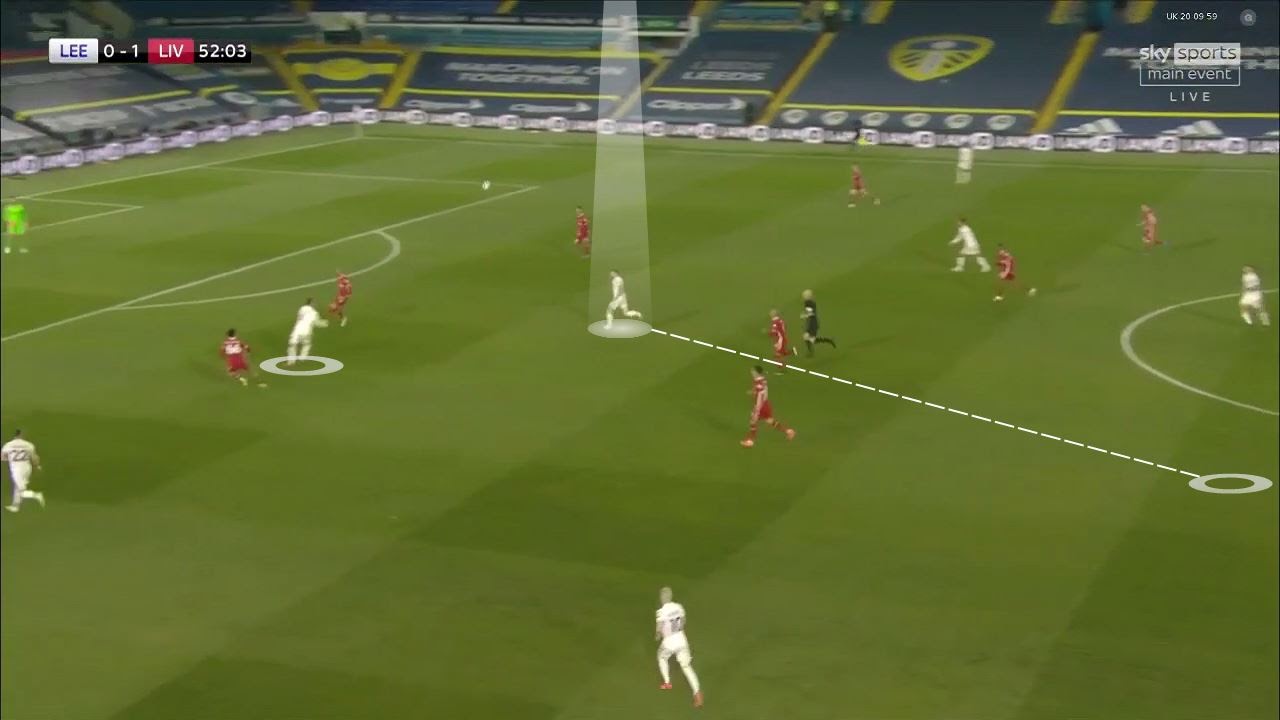
Diego Llorente gave a long ball targeted to Bamford. Dallas then took a diagonal run from the center-half towards the Liverpool box and tried to create a threat by making a quick one-two-one with Bamford.
Right Winger
Dallas has mainly played as a fullback or a midfielder throughout the season, but at the latter part of the season, for Raphinha’s injury and Costa’s off form, Dallas has been seen playing as a right-winger in 2-3 matches. As a right-winger, he usually stayed near the touchline area on the right side of the opponents’ half.
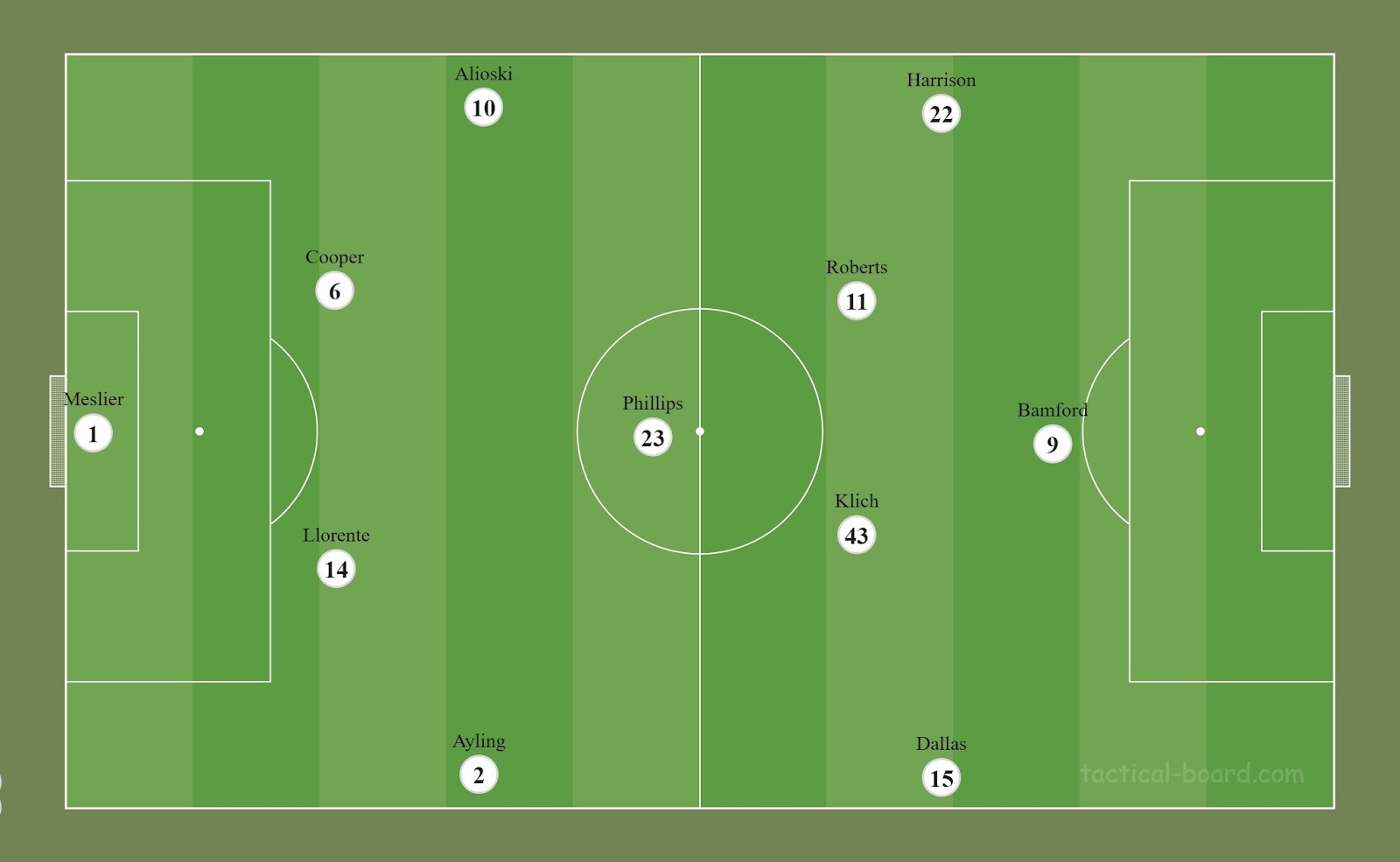
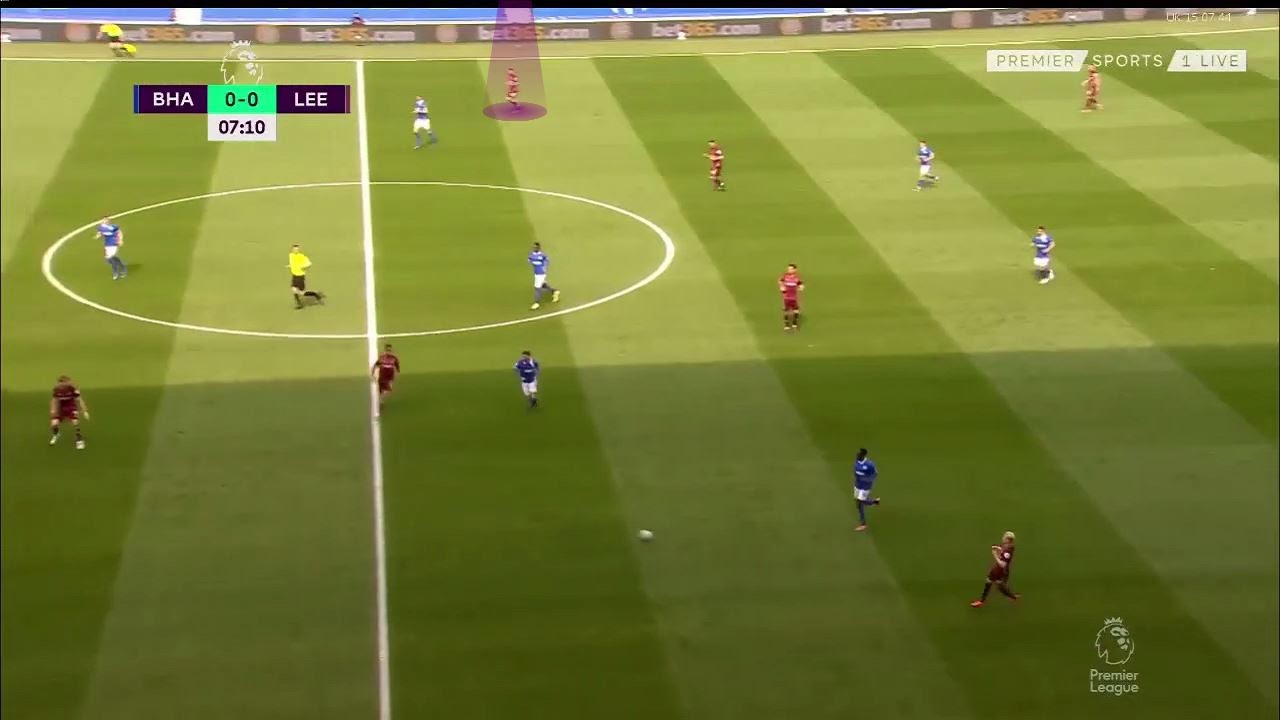
In the match against Brighton Dallas’s positioning as a right-winger. Dallas usually takes his position close to the touchline, but he has occasionally been seen making diagonal runs through half-spaces when the ball is not on his feet. Consequently, the opponent’s left-back tracked him and moved to the center area, so Ayling would get free space in the right-wing to make an overlapping run and push forward.
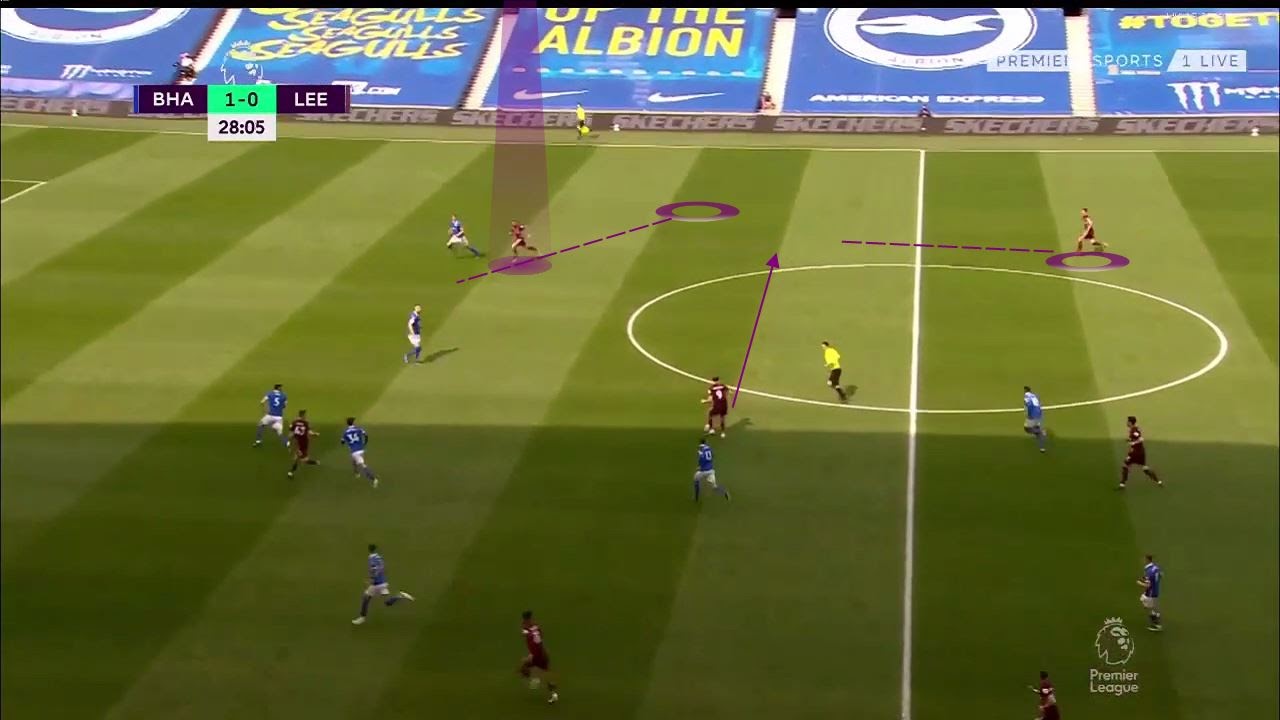
Dallas took a diagonal run in the right half-space while Bamford passed the ball in midfield. Brighton’s left-back tracked Dallas and moved centrally. At that time after making a forward run, the whole wide area in front of Ayling was opened.
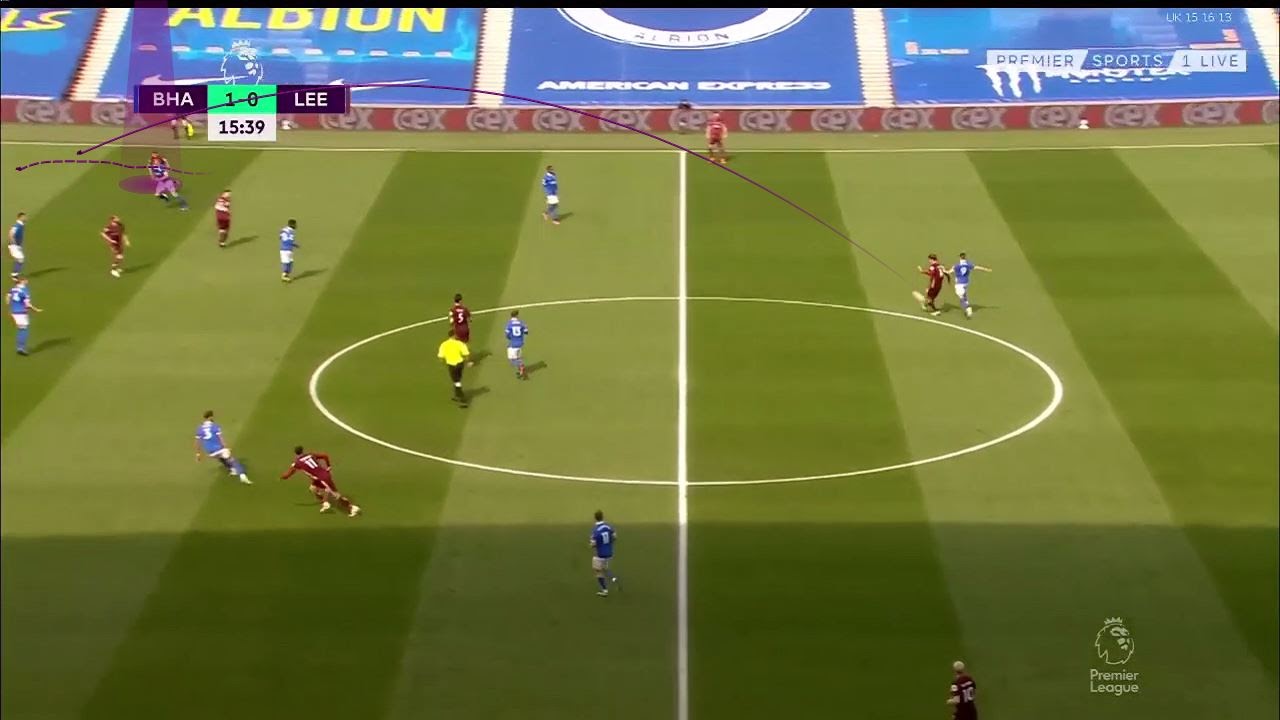
Dallas made a run behind the defense while Llorente had the ball at his feet. Llorente then attempted a long ball aimed at him.
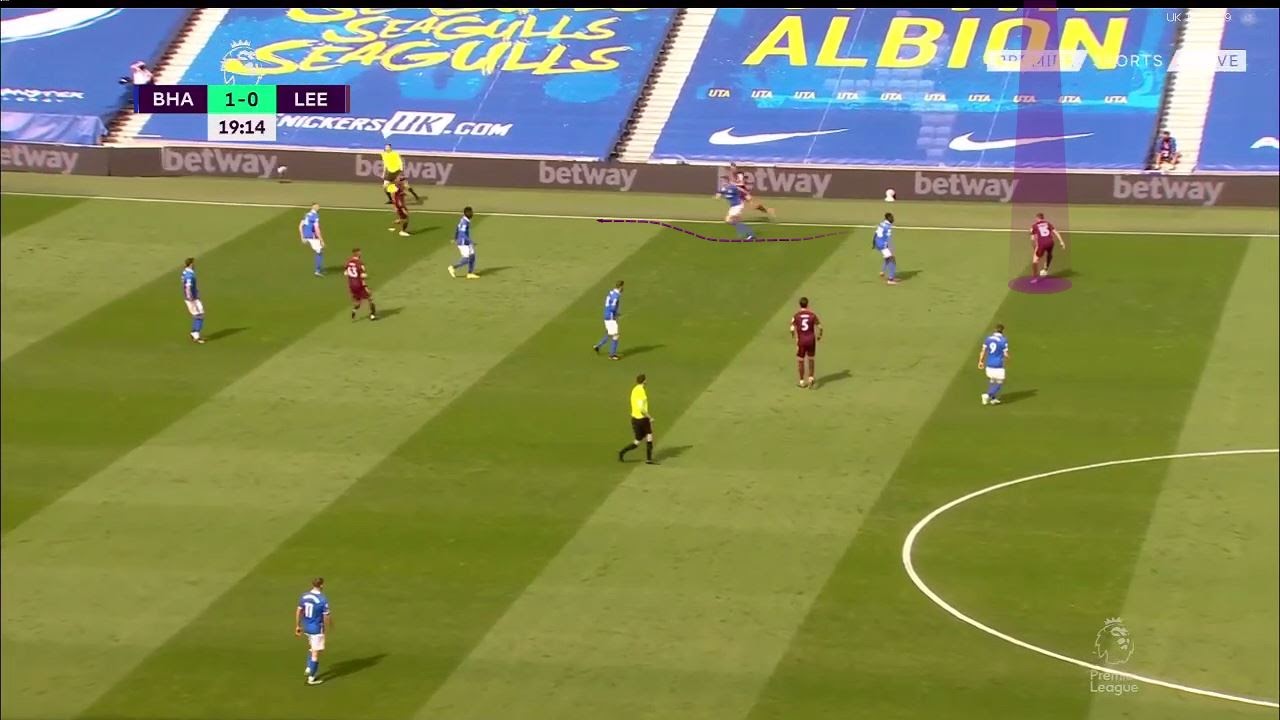
Despite playing in the winger position, Dallas occasionally dropped down and gave Ayling a chance to push forward.
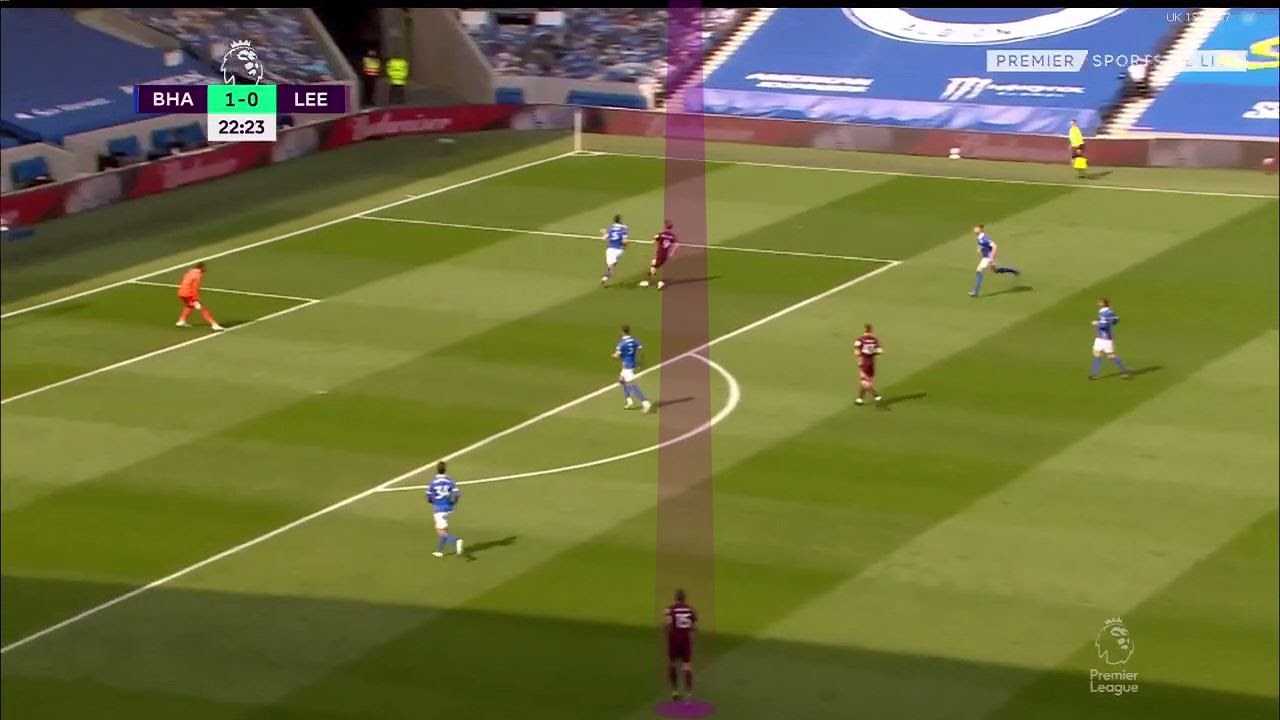
Although playing as a right-winger, Dallas would occasionally switch his position to the left. Through this, we also get proof of his versatility.
Conclusion
Throughout the 2020-21 season, Stuart Dallas’s form was great, with him playing in a variety of positions, but his form did not fall. Marcelo Bielsa has played him in a variety of roles throughout the season, but Dallas has easily adapted to those roles. Last season he played for the team as a left-back, right-back, midfielder, and sometimes even as a winger, but his performance in all the positions was great.
Dallas’s performance cannot be considered with just his 8 goals. Anyone who watched Dallas’s game live last season will be able to tell you how consistent Dallas was throughout the season and how important his performance was for Leeds.
By: Amartya Das Dip/ @amartyadasdip
Featured Image: @GabFoligno / Michael Regan – Getty Images
